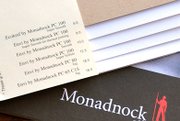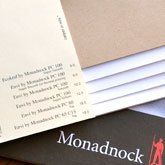New Labels From Nexgen Are Authentic and Green
It started as a sort of eco challenge.
Back in 2007, San Francisco–based Gap Inc. was looking to print more of its price tickets on environmentally friendly paper—but the company wasn’t looking to take on the added cost of an eco-friendly product.
The company was already printing the price tickets for its Gap division onpaper made from 30 percent post-consumer waste (PCW) and they wanted to increasethat to 100 percent PCW.
“We print hundreds of thousands of price tickets annually, and our packaging team identified an area where we could make a significant impact if we changed the materials that those price tickets were being made from,” said Melissa Swanson Fifield, director of Environmental Affairs and Global Responsibility for Gap Inc. “We are always looking at better ways to do business, but it has to be good for business, as well. The fact that we were able to do it in a cost-neutral manner is a win-win.”
To meet the challenge, Nexgen Packaging, a label and packaging company based in Ventura, Calif., partnered with Monadnock Paper Mills Inc. (MPM), a 192-year-old company based in Bennington, N.H.
But environmental impact and cost were not the only issues to consider, said Kent Pellegrini, Nexgen’s owner.
“In addition to increasing the PCW content, the price ticket paper stock needed to be highly calendarized to create a smooth enough surface for imprinting by thermal transfer printers,” he explained.
In order to print an easily readable barcode, thermal transfer printers need paper with a very smooth surface.
“The other challenges were related to having the mill’s water-treatment processes and environmental claims independently certified,” Pellegrini said. “Finally, the supply chain had to be put into place to ensure that the paper was readily available in both the United States and Asia.”
With a slight redesign of the tag, Nexgen was able to shift the retail giant’s price tickets to recycled paper—without incurring any additional costs.
The Gap subsequently rolled out the green tickets to its Old Navy, Banana Republic and outlet divisions, and Nexgen expanded the eco paper to other apparel brands and retailers. Today, the label company works with its customers to help re-engineer tickets and tags to make the switch to an eco paper cost-effective. The company calls the program “eco-sizing.”
“In order to assist them in keeping the switch cost-neutral, we have proposed ’eco –sizing’ their packaging to achieve a higher yield from the same press sheet,” Pellegrini said. “By decreasing the existing tag sizes by as little of fourth inch to a half inch, we were able to improve the press sheet yield by 10 percent to 30 percent, thereby allowing the shift to 100 percent PCW without any increased costs.”
Nexgen and MPM next developed Monadnock PC80. Used for pocket flashers, hangtags and some packaging, Monadnock PC80 is made from 80 percent post-consumer waste paper.
The companies’ latest development is Ecokraf, a recycled paper that has the authentic look of chipboard or kraft paper.
Label makers can mimic the look of chipboard using a four-color process image, but unlike Ecokraf, printed tags have a tell-tale white edge. “Designers don’t feel it’s authentic,” Pellegrini said.
“We saw a need in the market for paper that had the look of chipboard with the printing functionality of a white paper stock,” he said. “Historically, the marketing department wants chipboard look for aesthetics, while both the trim and sourcing departments want thermal imprintability at the garment factory.”
Ecokraf solved both dilemmas. MPM started with stock that is certified by the Forest Stewardship Council and made from 100 percent post-consumer waste paper. The stock is tinted with eco-friendly dyes “to achieve the traditional brown flecked appearance of kraft stock,” Pellegrini said.
And Ecokraf can be thermally printed.
Ecokraf is one of several environmentally friendly products offered by Nexgen, which also makes printed and woven labels made from certified recycled polyester yarns. The company carries non-green labeling products, as well. Pellegrini estimates about 5 percent to 7 percent of Nexgen’s products are eco-friendly, but he said he sees continued growth in green products.
For more information, visit www.nexgenpackaging.com.—Alison A. Nieder
Gap Takes the Story to the Web
The full story of Gap Inc.’s shift to price tickets made from 100 percent recycled post-consumer waste paper under the direction of Jorge Perez-Olmo and John Hodges, members of Gap’s global sourcing and packaging team, is available on the Gap Inc. website (www.gapinc.com).
Gap’s move to greener price tickets was one of the company’s earlier efforts to effect environmental and social change, said Melissa Swanson Fifield, director of environmental affairs and global responsibility for Gap Inc.
The company also changed its gift cards, which are now made from recycled materials and are recyclable. Plus, the eco-mindedness extends to the company’s corporate offices, as well.
“We’ve eliminated trash cans at peoples’ desks,” Fifield said. “They have to compost and recycle their own waste, which has had a significant impact not only on the amount of waste we’ve been able to divert from landfill but in the way people think about their day-to-day operations.”
The “social responsibility” section of Gap’s website outlines the retailer’s efforts from the corporate level down to the success stories of individual employees such as Perez-Olmo and Hodges. “The website is our platform to share, in a much more detailed fashion, the work we’re doing from a socially to environmental responsibility perspective,” Fifield said.























